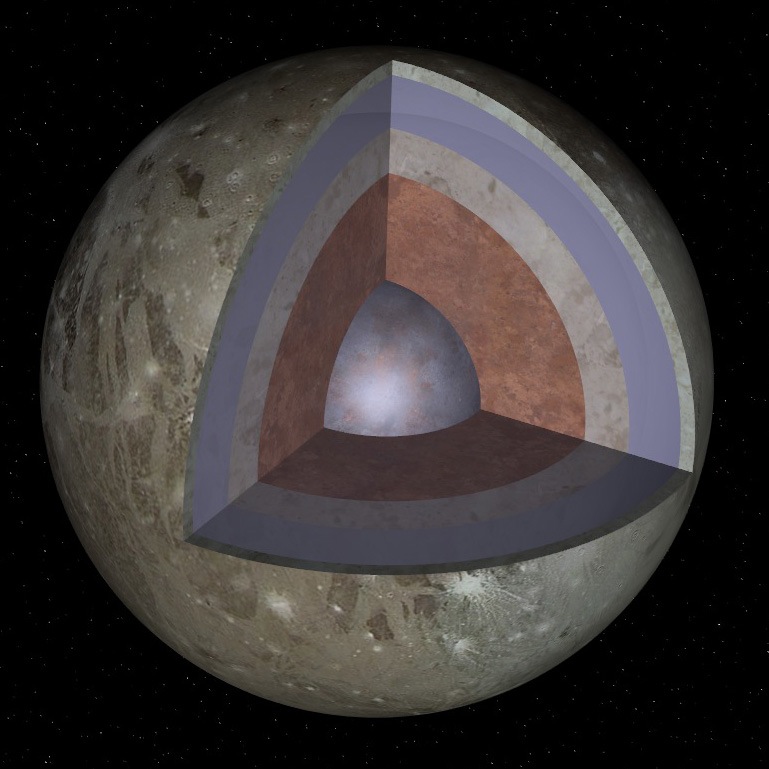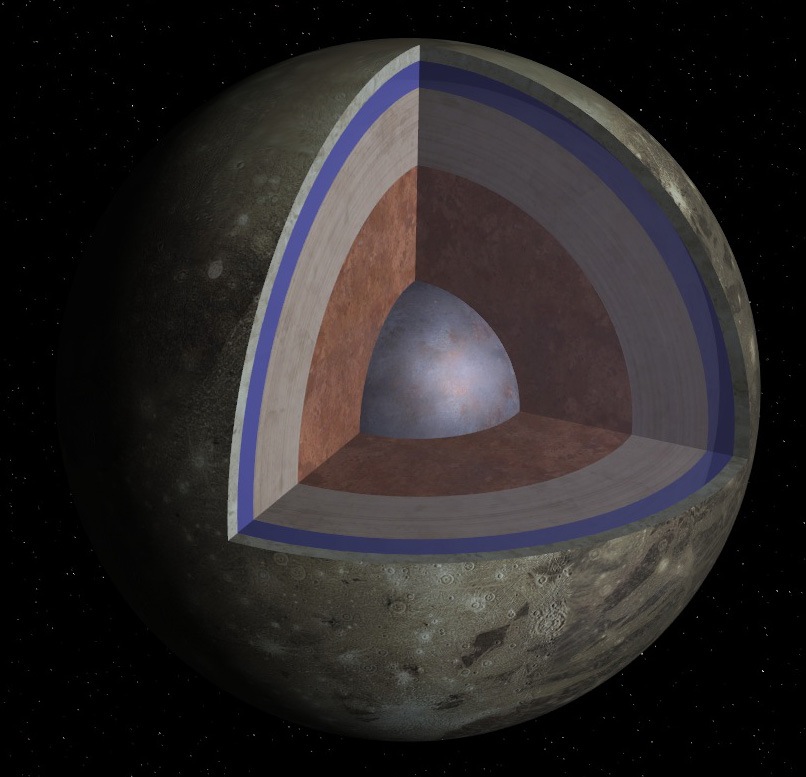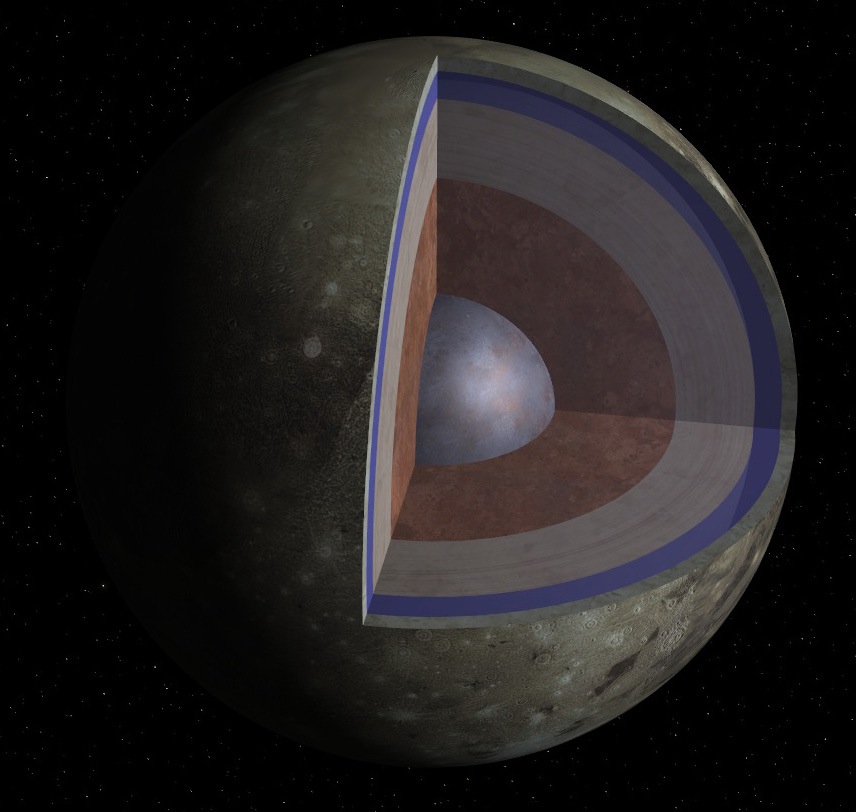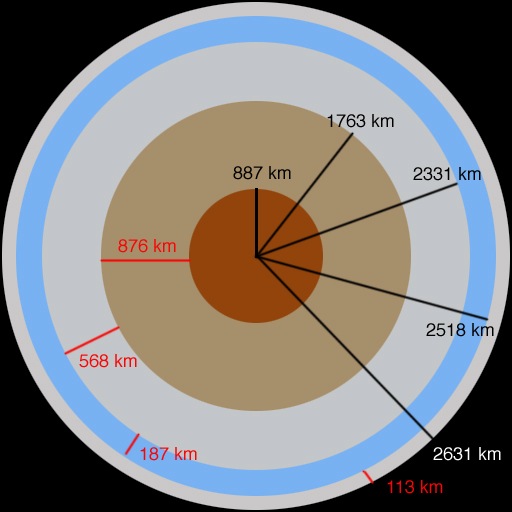Page 4 of 12
Posted: 19.04.2007, 01:47
by buggs_moran
Cham wrote:Here's a prototype model of Ganymede. I'm wondering if I should simulate the water filling with that gap between the inner mantle and the ice crust, with some fading out effect inside the water (transparent textures). Opinion, please ?
Sure, I like the effect on the Earth. Something like it here would be effective.
Posted: 19.04.2007, 01:50
by Cham
What do you mean ? Ganymede's interior is very different than Earth's.
I'm having some difficulties choosing the water aspect. What you guys prefer, the first picture, or the second ?


Posted: 19.04.2007, 06:47
by Adirondack
Cham wrote:Adirondack,
there's no typo in Gutenberg. For example, see that link :
http://en.wikipedia.org/wiki/Image:Slice_earth.svgIn all documentations I've seen on the net, it is spelled that way. In some rare cases, I also saw Gutemberg. Apparently, both ways are possible.
I referred to an earlier post of Andrea. He wrote:
... Gutemberg discontinuity= Discontinuit? di Gutemberg ...
I have been mislead by Andrea's post...
... spelling in your addon is correct.
And please, read again your own post : you used an "n" too !
Yes, of course since Gutenberg is correct.
Did we drop into a misunderstanding?
Adirondack
Posted: 19.04.2007, 06:51
by Adirondack
...

... ...

... ...

...
We are
not talking about Johannes Gutenberg (inventor of movable type printing) but about Beno Gutenberg (seismologist)!
 http://www.agu.org/inside/awards/gutenberg.html
http://www.agu.org/inside/awards/gutenberg.html 
Posted: 19.04.2007, 07:14
by ANDREA
Adirondack wrote:I referred to an earlier post of Andrea. He wrote:
... Gutemberg discontinuity= Discontinuit? di Gutemberg ...
I have been mislead by Andrea's post...
... spelling in your addon is correct. Adirondack
Adirondack, you are right, but my mistake is due to the Italian grammar rule, that
obliges to put "M" before "p" or "b" within a word, so in Italian Gute
mberg is right, Gute
nberg is wrong.
I know well that this is a full name, but rigid rules sometimes bring to mistakes.

Sorry for this.
Bye
Andrea

Posted: 19.04.2007, 09:40
by ajtribick
I prefer the first one (if only because there might not be an ocean) but I still think the ocean's too deep - taking the region suggested for the ocean in those papers I found, it should occupy about 3% of the radius of Ganymede.
In fact, the paper describing the possibility of extrasolar ocean planets suggests you can't get an ocean much deeper than about 100 km anyway.
Posted: 19.04.2007, 12:52
by ajtribick
Quick POV-ray mockup using the 170-250 km ocean looks like this:

White = upper ice (ice I)
Blue = ocean
Cyan = lower ice (ices V+VI)
Red = silicate mantle
Grey = metallic core (diameter taken to be 850 km, halfway between limits I mentioned)
Posted: 19.04.2007, 15:56
by Cham
Chaos,
thanks for your picture. I was also thinking about a model with layers of those proportions. However, there's something very puzzling here : the magnetic field generated by the moon. Apparently, AFAIK, Ganymede has a relatively pretty "strong" magnetic field which, according to some studies, should be generated by a "deep" ocean of salty water. I can't see how such a small layer of liquid water, as shown on your picture, could generate a significant magnetic field. Actually, the magnetic field is one of the first indices which pointed to a global internal ocean. The deep ocean can also help understanding the very large visible cracks and fractures on Ganymede's surface. Usually, the proportions you are showing may be more accurate for Callisto and/or Europa.
I'm really not a specialist on planetary dynamics, moons internal structure, etc, and all these matters are really interesting.
I need to talk to a professional specialist on galilean moons. If I can't find some satisfying "viable" or "plausible" proportions, I may abandon that moon model.

Posted: 19.04.2007, 16:18
by buggs_moran
Cham wrote:What do you mean ? Ganymede's interior is very different than Earth's.
I'm having some difficulties choosing the water aspect. What you guys prefer, the first picture, or the second ?
Sorry Cham. I know the interiors are different. I meant the interior movement at the different depths (simulating heat?). It looks like you used counter rotating cloud layers... I wondered if you could manipulate those to give a "water" effect.
I like the second one more, but would make the white cloudy effect in the water a little more blue. Also, is it possible to make the water layer a little translucent so we could see the rocky inner core through the water?
Posted: 19.04.2007, 17:28
by ajtribick
Cham wrote:However, there's something very puzzling here : the magnetic field generated by the moon. Apparently, AFAIK, Ganymede has a relatively pretty "strong" magnetic field which, according to some studies, should be generated by a "deep" ocean of salty water. I can't see how such a small layer of liquid water, as shown on your picture, could generate a significant magnetic field.
The thing is, there are two different phenomena going on with Ganymede's magnetic field. There's both an intrinsic magnetic field and an induced magnetic field. At present, Ganymede is unique among moons in the solar system to have its own intrinsic magnetic field (there's some suggestion that Io might, but the jury's out on that one). This is presumably generated in its core (which is how we know Ganymede has an iron core).
Then there's the induced magnetic field, which is generated by a conducting layer (e.g. a salty ocean) in response to it moving through Jupiter's magnetic field. This induced magnetic field is good evidence for oceans on Europa and Callisto. Detecting an induced magnetic field at Ganymede was made more difficult, because of the intrinsic field (the induced field is much weaker than the intrinsic one).
Posted: 19.04.2007, 18:06
by Cham
buggs_moran wrote:I like the second one more, but would make the white cloudy effect in the water a little more blue. Also, is it possible to make the water layer a little translucent so we could see the rocky inner core through the water?
Yes, the ocean layer is already transparent and showing the inner ice layer (look carefully at the pictures above). I could also add some motion effect, but I don't think it's really worth it, especially if I reduce the ocean thickness.
Posted: 19.04.2007, 20:34
by Fenerit
Cham, I believe that you can animate the ocean water with at least other 2 or 3 transparent spheres inside, without too much triangles, each one with a "waterly" clouds map that turn with different speed, inclination and alphablend percentage (bluish beneath and white above). Certainly, The difficults resides in texturing the map, where the waves could be sheared with some plug-ins that corredating various photo software.
For Aphyle2007: see below a screenshot of seismic wave collect from the 1991 Scientific American data whose I've cited to you some days ago. I've traslated the rectangular diagram in that of a circular sector. Tell me if all is wrong.
http://shutter08.pictures.aol.com/data/ ... dA0300.jpg
Posted: 19.04.2007, 20:37
by buggs_moran
HEY! I see it now. Too cool.
Posted: 19.04.2007, 21:06
by Cham
Fenerit wrote:Cham, I believe that you can animate the ocean water with at least other 2 or 3 transparent spheres inside, without too much triangles, each one with a "waterly" clouds map that turn with different speed, inclination and alphablend percentage (bluish beneath and white above). Certainly, The difficults resides in texturing the map, where the waves could be sheared with some plug-ins that corredating various photo software.
That's already what I've made for my Earth version (the "heat" effect), in a similar way as what you have done for your own version. This is a trivial trick in Celestia.
In the case of Ganymede, if the water layer is small, animation of water isn't worth it, and it may even make the model confused. Keep things simple.
Fenerit, how is the atmosphere behaving on the model you're showing on your last picture link ? How is it with the truncation, as seen from the sides ?
Posted: 19.04.2007, 21:40
by Fenerit
Yes Cham, by the side the atmosfere is circular as in your Sun's screenshot early posted. This is unavoidable. I maintain it only with the purpose of the screenshot's luminosity.
I've some images of Jovian's moon interiors "on paper" (8 years ago Scientific American), but I do not know if is correct to digitalize her and then post the result here without autorization, otherwise, if this was possible, I should digitalize her.
Posted: 19.04.2007, 23:03
by Cham
I lowered considerably the ocean thickness :


I'm not convinced by the textures I'm using, yet, for the various layers. I find the model a bit dull to watch in Celestia. Some text info should make it more interesting, but what to write ? We actually don't have much data to show in there. Any suggestions ?
Posted: 20.04.2007, 00:54
by Cham
Here's a schematic view of the proportions of the layers in my Ganymede model (shown above). The values used are a compromise between most of the papers I've found on the net. Of course, these numbers must be considered as rough "mean" values only. Comments, please ?

Posted: 20.04.2007, 04:20
by Cham
I'm not very satisfied with the Ganymede model. Texturing is hard to do well. I'm now testing a similar model for Europa. Thickness of ice crust is 40 km (the papers I've found are giving a thickness from 10 km to 50 km) and an internal ocean of 100 km thickness. Again, I feel uncomfortable with the mantle texture.

Posted: 20.04.2007, 11:56
by selden
Sometimes trying to be artistic can interfere with presenting the information. Plain high-contrast coloration, like in the flat diagram, might be more appropriate.
Posted: 20.04.2007, 18:13
by ajtribick
Still suspicious of the ocean depth there, but I guess if there's something like ammonia mixed in, it could get pretty deep (one estimate I saw was 350 km, but I'd really like to see a decent study of the ice shell - most papers out there focus on the core).
As for labels, I don't know. The core and mantle seem to be used fairly frequently as terms, but I really don't know what the terminology for the various layers of the ice shell would be.
Core - iron/iron sulfide (Fe/FeS)
Mantle - silicates
High-pressure ice (ice V/VI)
Ocean - water or water/ammonia
Crust (is this a good term?) - ice






